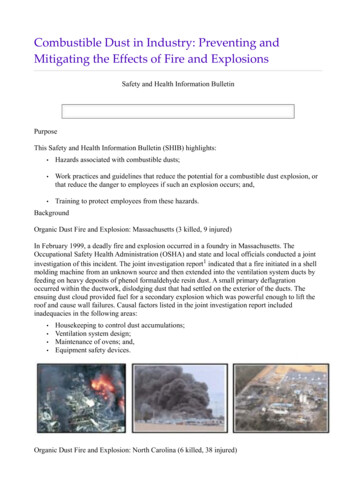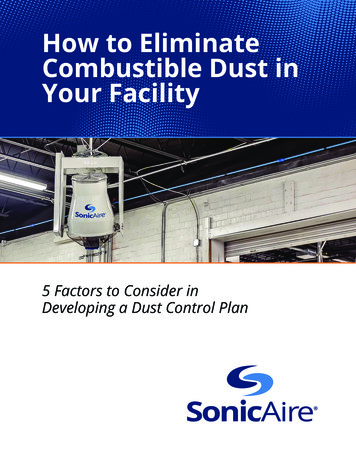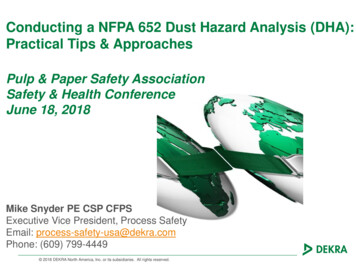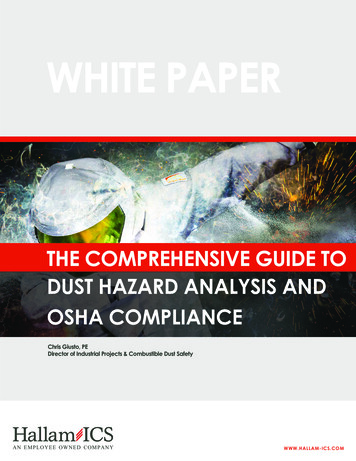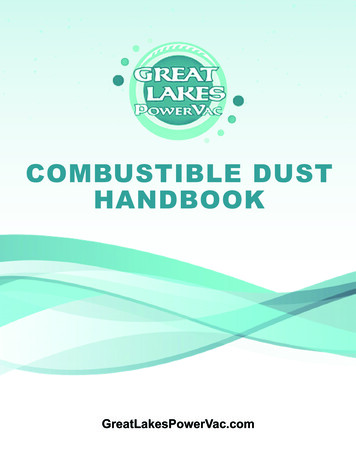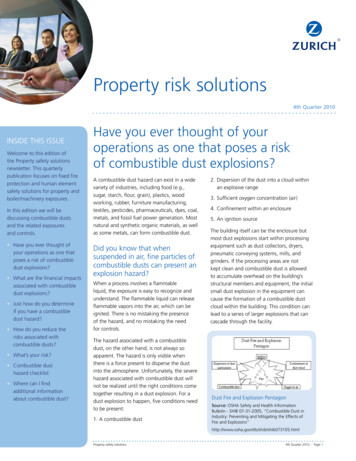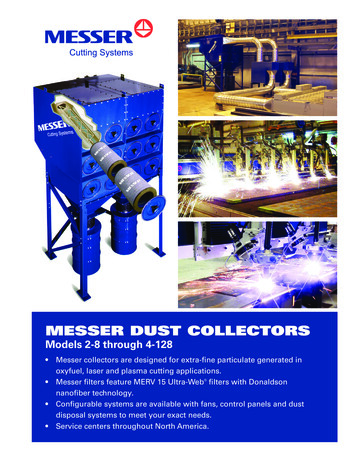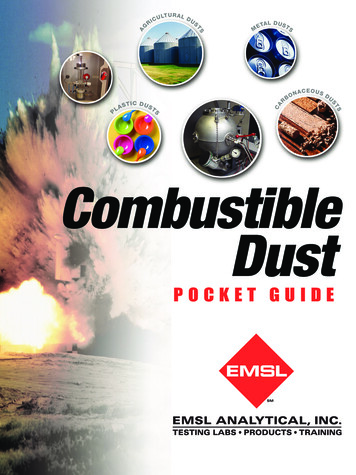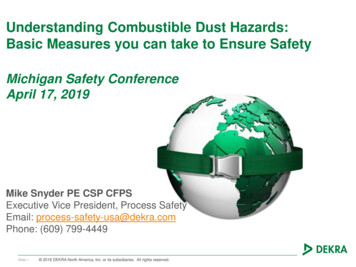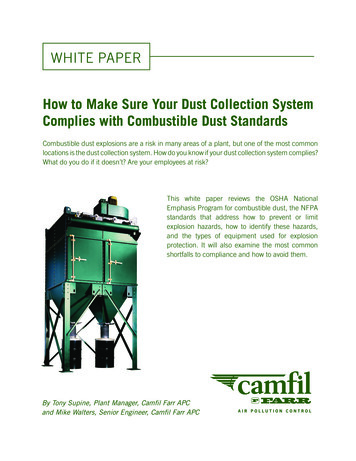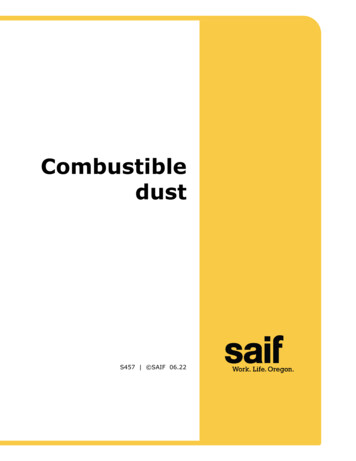
Transcription
CombustibledustS457 SAIF 06.22
Table of contentsWhat are the risks? .3Know the dust fire and explosion pentagon .3Avoid the secondary dust explosion .4Learn from serious accidents .4A recent Oregon OSHA investigation . 5Types of dusts found in incidents nationwide . 6Industries with dust incidents nationwide . 7National emphasis program .7Review your hazards and controls .8Resources .11This publication provides practical workplace safety and health information to assist you in making your place of work safer.It is not legal advice. SAIF has made every effort to bring significant Oregon Occupational Safety and Health Administration(Oregon OSHA) regulations to your attention. Nonetheless, compliance with Oregon OSHA remains your responsibility. Youshould read and understand all relevant Oregon OSHA regulations that apply to your job site(s). You may want to consult withyour own attorney regarding aspects of Oregon OSHA that may affect you.Note: The information in this publication is time sensitive. Do not rely upon this document if its publication date is more thanthree years old. Please check the “Safety and health” section of our web site at saif.com/safetyandhealth for a more recent,printable copy. You’ll also find a variety of other valuable safety information designed to help your business prevent injuriesand control costs.S457 SAIF 06.22 Page 2
What are the risks?Combustible dust explosion hazards exist in a variety of industries, including food (such as candy,starch, flour, and feed), plastics, wood, rubber, furniture, textiles, pesticides, pharmaceuticals,dyes, coal, metals (such as aluminum, chromium, iron, magnesium, and zinc), and fossil-fuelpower generation. The vast majority of natural and synthetic organic materials, as well as somemetals, can form combustible dust.The National Fire Protection Association (NFPA) Industrial Fire Hazards Handbook states:“Any industrial process that reduces a combustible material and some normally noncombustiblematerials to a finely divided state presents a potential for a serious fire or explosion.”The primary factor in an assessment of these hazards is whether the dust is combustible. Anymaterial that will burn in air in a solid form can be explosive when in a finely divided form.Different dusts of the same chemical material will have different ignitability and explosivecharacteristics, depending on many variables such as particle size, shape, and moisture content.One possible source for information on combustibility is the safety data sheet (SDS). However, donot rely on it as a sole source of information. In some cases, additional information, such as testresults, will be available from chemical manufacturers.Facilities should carefully identify the following to assess their potential for dust explosions: Materials that can be combustible when finely divided Processes that use, consume, or produce combustible dusts Open areas where combustible dusts may build up Hidden areas where combustible dusts may accumulate Means by which dust may be dispersed in the air Potential ignition sourcesKnow the dust fire and explosion pentagonThe following OSHA fire and explosion pentagon diagram shows that combustible dust explosionsinclude the three factors of the familiar fire triangle (fuel, heat, and oxygen), plus the factors ofdispersion of dust particulates and the confinement of the dust cloud.S457 SAIF 06.22 Page 3
Avoid the secondary dust explosionA primary dust explosion (deflagration) occurs when dustthat is suspended within a confined area (such ascontainer, room, ventilation system, or piece ofequipment) ignites and explodes.Depending on the amount of settled dust in the area, asmall primary explosion may cause powerful secondarydust explosions. A secondary dust explosion may alsofollow a primary non-dust explosion (such as natural gas,pressure, or vessel).Source: OSHAA secondary dust explosion is the result of dust accumulation inside an enclosed area beingdisturbed and lifted in the air, then ignited by the primary explosion. The following OSHAillustration shows the difference between a primary and secondary explosion.Source: OSHALearn from serious accidentsA number of combustible dust accidents have caused deaths and serious injuries. Here are someexamples to review and discuss during program reviews and employee training.Oregon incidents Commercial Furniture, Roseburg; May 16, 2006: An employee suffered second- and thirddegree burns on his hands and arms from a dust fire triggered after two workers changed abag filter on a powder coating line for office furniture. Willamette Industries, Albany; October 25, 2000: An employee died from burns from acombustible dust fire. Investigators found large amounts of wood flour and dust onequipment and lighting fixtures and determined that the fire was ignited from an employeechanging a light bulb that was covered in wood dust. Mill Rite Farms, Albany; August 8, 2002: Workers were processing feed pellets when thesystem failed. An employee went upstairs to investigate and was killed when dust in the airexploded and set off a fire. Two other employees suffered serious burns and smokeinhalation.S457 SAIF 06.22 Page 4
Ace International, Albany; August 11, 2003: A worker died after suffering burns and inhaling toxic,superheated air. A defective piece of electrical equipment created a spark that ignited wood flourand dust.Investigation photos:Source: OSHAView the entire Oregon Fatality Assessment and Control Evaluation investigation report fromthis link: 1.htmlA recent Oregon OSHA investigationWest Oregon Wood Products, Banks; July 31, 2014: Four employees escaped an explosion and fireat a facility that produces wood pellets. The dust collector exploded due to static electricity buildupand discharge. The collector did not have a proper bonding and grounding system. Largeaccumulations of settled dust were also noted.Source: OSHAS457 SAIF 06.22 Page 5
The resulting fireball traveled through the ductwork (not equipped with automatic fire dampers)into the plant’s work area and caused an explosion in the processing equipment. This explosionignited and melted the ceiling’s water barrier, which was an improper material. Molten plasticrained down onto the workers, but they were able to escape safely.Source: OSHATypes of dusts found in incidents nationwideOther, 7%Coal, 8%Inorganic, 4%Wood, 24%Plastic, 14%Food, 23%Metal, 20%Source: OSHA National Emphasis ProgramS457 SAIF 06.22 Page 6
Industries with dust incidents nationwideFurniture/Fixture,4%Other, 7%Food Products,24%Equipment Mfg,7%FabricatedMetals, 7%Electric Services,8%Wood Products,15%Rubbers/Plastics,8%Primary Metal,8%Chemical Mfg,12%Source: OSHA National Emphasis ProgramNational emphasis programOregon OSHA carries out the National Emphasis Program (NEP) for combustible dust in Oregon.You can view the program document here: https://osha.oregon.gov/OSHARules/pd/pd-268.pdfThe program covers Oregon OSHA health inspection scheduling in: Industries with more frequent or severe incidents Industries with potential for incidents Other sources such as referralsOregon OSHA health inspectors look at: Site conditions History of incidents Safety data sheets Dust accumulations Dust collectors, ductwork, and other containers Efforts to abate the hazardCommon violations found in their inspections include: Improper housekeeping (floors and other surfaces). Often, settled dust inches-thick isfound. Improper electrical equipment (portable shop lighting, light socket on wall) Blowdown wands used at high pressure ( 30 psi)S457 SAIF 06.22 Page 7
Improper dust collection system (location, type, controls)Violations are rated low probability/serious injury or low probability/death depending on thehazards found.Oregon OSHA’s Occupational Health Laboratory and federal OSHA’s Salt Lake City Technical Centerhave conducted testing on dust collected during inspections and consultations. In most cases, thedusts were found to be combustible and included these kinds of materials: Wood dust/products Paper and cardboard dust Agricultural products: pumpkin, corn powder, soy flour, hay, grass seed dust, wheat dust,bamboo dust Metal dust: titanium and aluminum Other dusts: carbon black, carbon fiber, fiberglass resin, rubber, Corian, urea glue, bedliner,PVC dust, powder coating dustReview your hazards and controlsUse this tool to assess a facility’s potential dust explosion hazards and the controls in place. Referto the Resources section that follows for more detailed information.Step 1: Find out if the company processes any of these products or materials in powdered form. Ifso, there’s a potential for a combustible dust explosion.Source: OSHA federal OSHA Combustible Dust Poster ions/combustibledustposter.pdf)S457 SAIF 06.22 Page 8
Step 2: Assemble a review team.Work with knowledgeable employees from within the facility, including the facility safety manager,production superintendent or supervisor, equipment operators, electrician or electrical engineer,and maintenance employees or mechanical engineer.Each employee should provide knowledge into the processes and equipment throughout the facility.The production superintendent and supervisors should provide a detailed knowledge of the processfrom beginning to end. They should be able to identify raw materials, intermediate materials, andthe final product. Equipment operators will be able to provide insight on how the equipmentoperates, its operating parameters, and sources of fugitive dust emissions. An electrician orelectrical engineer should be able to provide information on Class II and Class III locations, and ifequipment and wiring meet the requirements for hazardous locations. Maintenance employees or amechanical engineer should provide maintenance records and service logs for equipment. Moreimportantly, these are the individuals who may be assigned to remedy fugitive dust emissions,implement preventative maintenance programs, or make modifications to material transfer points.Step 3: Confirm combustible dust hazard controls are in place.Materials used and past incidents Review safety data sheets (SDSs) and related information for the chemicals and materialsused or processed to determine the potential to create combustible dusts. If the facility has a history of fires and explosions involving combustible dusts, review thepotential causes of these incidents and the preventive measures put in place following theincidents.Dust control measures Make sure settled dust layers on horizontal surfaces, including exposed rafters, do notexceed a depth of 1/32 inch, either on:‒ More than 5 percent of all horizontal surfaces for a building up to 20,000 square feet, or‒ Up to 1,000 square feet for buildings greater than 20,000 square feet.Confirm the dust-containing systems (ducts and dust collectors) are designed in a way that doesnot expose employees to hazards, nor allow fugitive dusts to accumulate in the work area.Examples include:‒ No leaking of dust into work area‒ Collected air exhausted to the outside‒ Dust collectors not located inside buildings (some exceptions)‒ Dust collector cleaning locations away from the work area‒ Isolation devices to prevent deflagration propagation (spreading) between pieces ofequipment connected by ductwork The working surfaces are designed to minimize dust accumulation and facilitate cleaning. The facility has a housekeeping program with regular cleaning frequencies established forfloors and horizontal surfaces (such as ducts, pipes, hoods, ledges, beams, cable trays, andS457 SAIF 06.22 Page 9
on and around equipment) to minimize dust accumulations within operating areas of thefacility. The cleaning methods used prevent combustible dusts from being suspended in the air.High-efficiency (HEPA) vacuum cleaning equipment or wet methods are recommended.Blowing off the settled dust with compressed air is discouraged.1. This housekeeping hierarchy is followed:2. Vacuum is preferred method, intrinsically safe, and is a central system.3. Water washdown or sweeping (not vigorously)4. Compressed air is only used for hard-to-reach areas. Processes with ignition sourcesshut down, air pressure is limited, and work is done in small zones.Ignition control measuresConsider potential ignition sources, including open sparks or flames from welding or abrasivecutting or grinding; embers; electrical equipment; static sparks; and hot surfaces (such as dryers,extruders, and heaters). Electric cleaning devices, such as sweepers or vacuum cleaners, and electrical equipmentare approved for the combustible dust locations. Spark detection and fire and explosion suppression systems are well designed andmaintained. The facility has an ignition control program, such as grounding and bonding and othermethods, for dissipating any electrostatic charge that may be generated while transportingthe dust through the ductwork. The facility has separator devices to remove foreign materials capable of ignitingcombustible dusts (such as iron filings). The facility has a Hot Work Program, including performing hot work in approved locations;written permitting procedures for hot work outside of designated areas; fire watchertraining; and fire extinguisher user training. Combustible dust locations and other areas where smoking is prohibited are posted with “NoSmoking” signs. Duct systems, dust collectors, and dust-producing machinery are constructed ofnoncombustible materials and are bonded and grounded to minimize accumulation of staticelectrical charge. The facility selects and uses powered industrial trucks (such as forklifts and loaders) thatare approved for the combustible dust locations. Consult with fire prevention specialists from your property insurance carrier on the optionsand resources for conducting infrared (IR) thermography studies to identify potentialignition sources.Prevention measures Safety data sheets (SDSs) or other information for the chemicals and materials that couldbecome combustible dusts are available to employees. Employees have had hazard awareness training on the fire and explosion hazards ofcombustible dusts and the control methods.S457 SAIF 06.22 Page 10
Protection measures The facility has an emergency action plan. Rooms, buildings, or other enclosures (dust collectors) have explosion relief ventingdistributed over the exterior wall of buildings and enclosures and directed away from workareas. Emergency exit routes are maintained properly to allow clear and visible exit routes. The personal protective equipment (PPE) has been selected for the job tasks involvingcombustible dusts, including:‒ The need for flash-resistant clothing has been determined for employees required towork in environments where combustible dust hazards exist.‒ Airborne concentrations of respirable dust have been evaluated to determine theneed for respirators.‒ A written respiratory protection program that includes respirator selection, training,medical screening, and fit testing, is in place where respirators are needed. Consult with the fire prevention specialists from your property insurance carrier on the fireprotection system, including:‒ Automatic sprinkler system is designed for the occupancies present and commoditiesstored.‒ Water supply is adequate for the system design.‒ Idle pallets and flammable liquids are stored properly for the system design.ResourcesOregon OSHACombustible dust hazard 17.pdfCombustible dust national emphasis program inspection 268.pdfFederal OSHACombustible dust topic .htlCombustible dust lications/combustibledustposter.pdfCombustible dust in industry: Preventing and mitigating the effects of fire and htmlWorkSafe BC (British Columbia)Injury Prevention Resources for Wood Products ards-ofcombustible-dusts-in-manufacturing?lang enS457 SAIF 06.22 Page 11
Institute for Occupational Safety and Health (Germany)Dust explosion database search for testing results for various x?lang eNational Fire Protection Association (NFPA)Related codes and standardshttps://catalog.nfpa.org/NFPA 61, Standard for the prevention of fires and dust explosions in agricultural and foodprocessing facilitiesNFPA 68, Guide for venting of deflagrationsNFPA 69, Standard on explosion prevention systemsNFPA 70, National electric codeNFPA 77, Recommended practice on static electricity NFPA 86, Standard for ovens and furnacesNFPA 91, Standard for exhaust systems for air conveying of vapors, gases, mists, andnoncombustible particulate solidsNFPA 484, Standard for combustible metalsNFPA 499, Recommended practice for the classification of combustible dusts and of hazardous(classified) locations for electrical installations in chemical process areasNFPA 654, Standard for the prevention of fires and dust explosions from the manufacturing,processing, and handling of combustible particulate solidsNFPA 664, Standard for the prevention of fires and explosions in the wood processing andwoodworking facilitiesNFPA 2113, Standard on selection, care, use, and maintenance of flame-resistant garments forprotection of industrial personnel against flash fireNFPA 85, Boiler and combustion systems hazard codeOregon Occupational Fatality Assessment and Control Evaluation (OR-FACE) ProgramFatality face/S457 SAIF 06.22 Page 12
The following OSHA fire and explosion pentagon diagram shows that combustible dust explosions include the three factors of the familiar fire triangle (fuel, heat, and oxygen), plus the factors of dispersion of dust particulates and the confinement of the dust cloud.
